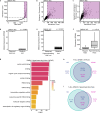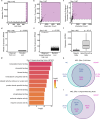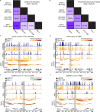Enhancer-promoter hubs organize transcriptional networks promoting oncogenesis and drug resistance
- PMID: 39277592
- PMCID: PMC11401928
- DOI: 10.1038/s41467-024-52375-6
Enhancer-promoter hubs organize transcriptional networks promoting oncogenesis and drug resistance
Abstract
Recent advances in high-resolution mapping of spatial interactions among regulatory elements support the existence of complex topological assemblies of enhancers and promoters known as enhancer-promoter hubs or cliques. Yet, organization principles of these multi-interacting enhancer-promoter hubs and their potential role in regulating gene expression in cancer remain unclear. Here, we systematically identify enhancer-promoter hubs in breast cancer, lymphoma, and leukemia. We find that highly interacting enhancer-promoter hubs form at key oncogenes and lineage-associated transcription factors potentially promoting oncogenesis of these diverse cancer types. Genomic and optical mapping of interactions among enhancer and promoter elements further show that topological alterations in hubs coincide with transcriptional changes underlying acquired resistance to targeted therapy in T cell leukemia and B cell lymphoma. Together, our findings suggest that enhancer-promoter hubs are dynamic and heterogeneous topological assemblies with the potential to control gene expression circuits promoting oncogenesis and drug resistance.
© 2024. The Author(s).
Conflict of interest statement
The authors declare no competing interests.
Figures







Update of
-
Enhancer-promoter hubs organize transcriptional networks promoting oncogenesis and drug resistance.bioRxiv [Preprint]. 2024 Jul 2:2024.07.02.601745. doi: 10.1101/2024.07.02.601745. bioRxiv. 2024. Update in: Nat Commun. 2024 Sep 14;15(1):8070. doi: 10.1038/s41467-024-52375-6. PMID: 39005446 Free PMC article. Updated. Preprint.
References
Publication types
MeSH terms
Substances
Associated data
- Actions
- Actions
- Actions
- Actions
- Actions
- Actions
Grants and funding
LinkOut - more resources
Full Text Sources
Molecular Biology Databases

